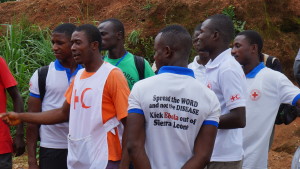Sierra Leone's House-to-House Campaigns
 The MOHS, in collaboration with UNICEF, WHO, other partners, and line ministries, conducted a nationwide house-to-house family sensitization campaign in September 2014, with the specific objectives to:
The MOHS, in collaboration with UNICEF, WHO, other partners, and line ministries, conducted a nationwide house-to-house family sensitization campaign in September 2014, with the specific objectives to:
Reach 100 percent of households in the country with correct information on Ebola
Increase community acceptance of Ebola affected persons, especially children
Promote handwashing with soap at the household level
Rebuild public confidence and trust in the health system
Install neighborhood watch structures at community level
Planning and Preparation
Undertaking an ambitious intervention of this scale required a massive amount of planning and coordination in a very short period of time. A National Task Force (NTF) committee of the MOHS, including representatives of all partners in health care delivery and chaired by the Director of Disease Prevention and Control, was the key planning and implementation force. The Task Force created subcommittees for various aspects of the effort, and met daily for weeks before the event. A comprehensive national and district SM plan was developed by the Task Force’s SM subcommittee in collaboration with the Health Education Unit, MOHS, and partners.
To prepare a huge number of community mobilizers for this undertaking, a cascade-style training and orientation took place. Additionally, journalists were oriented and given bi-weekly briefings to promote reporting of correct information on the disease to reduce rumors, fear, panic and resistance among the general public.
Implementation
Visits. More than 30,000 people in 7,136 teams reached 1.3 million people. The teams included MOHS technical personnel, as well as community volunteers including teachers, youth and NGO/CBO staff, along with monitors and supervisors. Meeting with all members of the household, including children, the team discussed Ebola and provided a bar of soap to promote handwashing. The family then answered questions that allowed the volunteers to determine if there were potential Ebola cases or deaths in the household. Each household received print materials and a small sticker with an Ebola prevention message that was applied to their doorway. The team distributed more than 1.7 million pieces each of soap, household stickers, flyers and other materials, and visited over 94 percent of the households in the country during the three days.
Radio and Television. There was a simulcast radio program broadcast each of the three days, linking 45 radio stations nationwide providing educational programming with talks by experts in 10 languages as well as Ebola related jingles, spots, songs and phone-ins by community members to ask questions and give feedback. Critical issues on Ebola prevention and control were discussed to educate the public on the disease during the three-day “sit at home” period. Television programs and talk shows were also aired. Prominent experts on the epidemic discussed contact tracing, reduction of stigma and discrimination against health workers and Ebola survivors, case management and safe burials.
Supplies and equipment. To ensure that trust was reestablished in the health system, rapid response teams were set up to ensure that surveillance officers and contact tracers, food supply teams, specimen collection staff, and evacuation and burial teams provided the required service(s) within 2 to 24 hours of reporting. Additional beds were added in holding centers and treatment units for early isolation of suspected and probable cases, laboratory capacity was increased to test more specimens, and additional ambulances and burial vehicles were added to transfer cases and remove corpses from homes and communities.
Nigeria’s Ebola Communication Response
 In Nigeria, the most critical factor for responding swiftly to the Ebola outbreak was the leadership and engagement from the head of state and the Minister of Health, with a focus on rapid isolation, containment and extensive contact tracing. Generous allocations of government funds and their quick disbursement helped as well. Partnership with the private sector was yet another asset that brought in substantial resources to help scale-up control measures that would eventually contain the Ebola virus.
In Nigeria, the most critical factor for responding swiftly to the Ebola outbreak was the leadership and engagement from the head of state and the Minister of Health, with a focus on rapid isolation, containment and extensive contact tracing. Generous allocations of government funds and their quick disbursement helped as well. Partnership with the private sector was yet another asset that brought in substantial resources to help scale-up control measures that would eventually contain the Ebola virus.
Health and government officials rallied communities to support containment measures. House-to-house information campaigns and messages on local radio stations in local dialects explained the level of risk, effective personal preventive measures and the actions being taken for controlling the epidemic. Media were trained, briefed and engaged as partners in the Ebola response. For his part, the President reassured the country’s vast and diversified population through appearances on nationally televised newscasts. The campaign exploited the full range of media opportunities—from social media to televised facts about the disease delivered by well-known “Nollywood” movie stars.
Liberia’s Ebola Communication Response in Lofa County
 Lofa County has one of the highest cumulative incidences of EVD in Liberia. Studies suggest that transmission of Ebola virus decreased as early as August 17, 2014, following rapid scale-up of response activities in Lofa County after a resurgence of Ebola in early June 2014. The identified key to this local success story is local leadership and active community engagement. The comprehensive response strategy developed with participation from the local population in Lofa County might serve as a model to implement in other affected areas to accelerate control of Ebola.
Lofa County has one of the highest cumulative incidences of EVD in Liberia. Studies suggest that transmission of Ebola virus decreased as early as August 17, 2014, following rapid scale-up of response activities in Lofa County after a resurgence of Ebola in early June 2014. The identified key to this local success story is local leadership and active community engagement. The comprehensive response strategy developed with participation from the local population in Lofa County might serve as a model to implement in other affected areas to accelerate control of Ebola.

